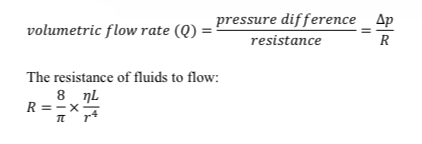
Fluid flow
Fluid mechanics
In human body; Blood in circulatory system, air in respiratory system.
Blood and aid are considered to be fluids and the tubes are assumed to have rigid walls. The main concept of fluid flow is pressure.
Pressure in fluids
Static pressure: ratio of force exerted on a certain area.
pstatic = F/A unit; Pascal(Pa) in medicine we use mmHg, 1mmHg = 133.3Pa.
Hydrostatic pressure: considering resting fluids, pressure due to the weight of a fluid.
phydrostatic = 𝜌𝑔h 𝜌 = 𝑚/𝑉
High pressure — low pressure, pressure at IV point is larger than atmospheric pressure so Hydrostatic pressure provides the pressure difference.
Dynamic pressure: if a fluid is moving at certain speed it has kinetic energy, this pressure is the kinetic energy of a fluid with a given volume.
𝑝𝑑𝑦𝑛𝑎𝑚𝑖𝑐 = 𝑘𝑖𝑛𝑒𝑡𝑖𝑐/𝑉 = 1/2 mv^2/𝑉 = 1/2 𝜌v^2
Pascals principle if pressure is applied to an enclosed system it is transmitted undiminished in the system.
Medical relevance: RADIAL PULSE; due to periodicity of the heart cycle the changing pressure can be detected as palpitations at the arteries and also find out number of heartbeats.
Viscosity
The magnitude of internal friction of a liquid.
𝜂= (𝐹/𝐴)/ velocity gradient
Classification of liquids based on viscosity
• Ideal fluids: viscosity = 0
• Real fluids:
a) Newtonian: constant viscosity .
b) Non-Newtonian: not constant viscosity.
- Blood; ~2-4mPa
- Synovial fluid; ~400mPa
Fluid flow
Consequence of viscosity understood as internal friction. If there is no viscosity there will be no internal friction between the fluid.
Streamlines visualize the fluid flow, its tangent gives info. on velocity direction and its density is proportional to the velocity.
Stationary flow: the streamlines do not change at any point.
Laminar flow: when the streamlines are parallel to each other. Speed of fluid is relatively small and below critical speed.
Turbulent flow: we have relatively circular streamlines and speed of the fluid is faster. Above critical speed.
Reynolds number(R)
vcritical = R𝜂/𝑟𝜌
* Generally blood flow is laminar but can occasionally be turbulent.
Volumetric flow rate
Q = V/t = Av
For an ideal fluid speed is constant
Continuity equation
It considers the incompressiblity of fluids.
A1v1 = A2v2
When area increases the speed decreases.

Bernoullis principle tells us that the sum of the pressures is constant.
If the speed decreases the pressure will increase. When area increases the speed decreases and the pressure increases.
Hagen-Poiseuille’s law the change in pressure is proportional to the resistance of fluids.

Stokes law describes the movement of a spherical object in a viscous medium.
𝐹 = 6𝜋𝜂𝑟𝑣
Mobility is 1/F
Fluid flow
Fluid mechanics
In human body; Blood in circulatory system, air in respiratory system.
Blood and aid are considered to be fluids and the tubes are assumed to have rigid walls. The main concept of fluid flow is pressure.
Pressure in fluids
Static pressure: ratio of force exerted on a certain area.
pstatic = F/A unit; Pascal(Pa) in medicine we use mmHg, 1mmHg = 133.3Pa.
Hydrostatic pressure: considering resting fluids, pressure due to the weight of a fluid.
phydrostatic = 𝜌𝑔h 𝜌 = 𝑚/𝑉
High pressure — low pressure, pressure at IV point is larger than atmospheric pressure so Hydrostatic pressure provides the pressure difference.
Dynamic pressure: if a fluid is moving at certain speed it has kinetic energy, this pressure is the kinetic energy of a fluid with a given volume.
𝑝𝑑𝑦𝑛𝑎𝑚𝑖𝑐 = 𝑘𝑖𝑛𝑒𝑡𝑖𝑐/𝑉 = 1/2 mv^2/𝑉 = 1/2 𝜌v^2
Pascals principle if pressure is applied to an enclosed system it is transmitted undiminished in the system.
Medical relevance: RADIAL PULSE; due to periodicity of the heart cycle the changing pressure can be detected as palpitations at the arteries and also find out number of heartbeats.
Viscosity
The magnitude of internal friction of a liquid.
𝜂= (𝐹/𝐴)/ velocity gradient
Classification of liquids based on viscosity
• Ideal fluids: viscosity = 0
• Real fluids:
a) Newtonian: constant viscosity .
b) Non-Newtonian: not constant viscosity.
- Blood; ~2-4mPa
- Synovial fluid; ~400mPa
Fluid flow
Consequence of viscosity understood as internal friction. If there is no viscosity there will be no internal friction between the fluid.
Streamlines visualize the fluid flow, its tangent gives info. on velocity direction and its density is proportional to the velocity.
Stationary flow: the streamlines do not change at any point.
Laminar flow: when the streamlines are parallel to each other. Speed of fluid is relatively small and below critical speed.
Turbulent flow: we have relatively circular streamlines and speed of the fluid is faster. Above critical speed.
Reynolds number(R)
vcritical = R𝜂/𝑟𝜌
* Generally blood flow is laminar but can occasionally be turbulent.
Volumetric flow rate
Q = V/t = Av
For an ideal fluid speed is constant
Continuity equation
It considers the incompressiblity of fluids.
A1v1 = A2v2
When area increases the speed decreases.

Bernoullis principle tells us that the sum of the pressures is constant.
If the speed decreases the pressure will increase. When area increases the speed decreases and the pressure increases.
Hagen-Poiseuille’s law the change in pressure is proportional to the resistance of fluids.

Stokes law describes the movement of a spherical object in a viscous medium.
𝐹 = 6𝜋𝜂𝑟𝑣
Mobility is 1/F
 Knowt
Knowt
